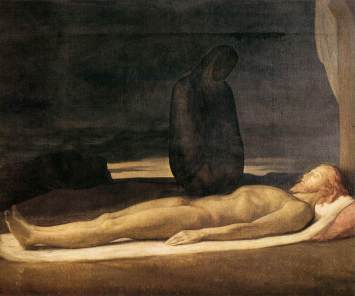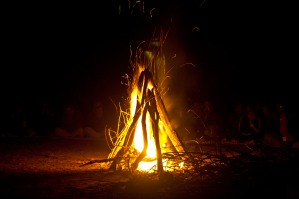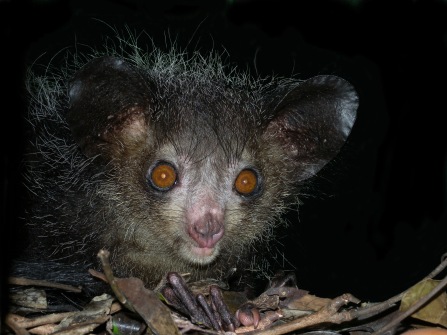Content warning: Sexual violence and supernatural endowment.
Smiles are contagious, but so are screams. In February 1995, fear spread like a disease among the inhabitants of Pemba, one of the two main islands that make up the Zanzibar archipelago. Much like the killer clown hysteria that hit the states last year, as the panic escalated, so did the violence.

An example of a nighttime visitor, courtesy of Wikimedia commons
If you’re the type of person to read Monster Meet, chances are you’re familiar with the concept of incubi and succubi, horrificly rapey nighttime visitors that like to wake people by crushing their lungs. The Popobawa is an incubus on steroids. Its name translates roughly to “bat wing,” but other than maybe casting a shadow in that shape, the creature does not conform to its label. A popular Western misconception is that the Popobawa looks like a one-eyed goblin with wings, but in reality it is a shapeshifter that has appeared in various forms: animal, humanoid, amorphous shadow, etc. It attacks everyone, from strapping men to small children, and unlike many other Zanzibar spirits, cannot easily be expelled or protected against.
Much of the West’s information about the outbreak of ‘95 comes from anthropologist Martin Walsh, who happened to be living on Pemba at the time. It was March 12th, just after Ramadan ended, and until then Walsh hadn’t paid much attention to his neighbors’ anxious talk. He slept through the worst of what happened that night, but in the morning, his watchman Salim filled him in.
The Popobawa had been disturbing the inhabitants of Pemba for about a month, smothering sleepers or scaring the bejeezus out of them with poltergeist-like shenanigans. People were frightened enough to abandon their bedrooms and start sleeping outside in groups, next to large, bright fires. But Salim could not be in a group that night. Instead he stood alone, on watch duty for the open entrance to Walsh’s compound. On edge in the dark yard, he saw movement and looked up to find a white dog right in front of him, staring at him and shuddering.
Salim felt his hackles go up. He loudly shooed the dog away, and was relieved to have it gone. But a few minutes later another strange animal took its place, also trembling and peering at him. Salim forced that one away, too, and then returned to his post, doubtless starting to sweat. He turned at a noise and found a dwarf staring at him now, shaking as uncontrollably as its predecessors. Bursting with adrenaline, Salim made a run at him; the dwarf hopped around some Land Rovers in the lot before disappearing into the dark. Scared shitless, Salim finally abandoned his post. He ran to check on his family, and didn’t tell Walsh what had happened until the next day.
When Walsh heard Salim’s story, he knew he had to investigate. In one night, the Popobawa (or mapopobawa, plural) had not only visited his compound, but had lead a frenzy of assaults and possessions that made people run wildly through the streets and into nearby rice valleys. With the help of his neighbor Jamila, Walsh began to collect stories from the people on the island with the hope of figuring out what the hell was going on.
It turned out that the Popobawa wasn’t new. Its first attacks came in 1965, shortly after a bloody revolution in 1964. Back then, as many as ten people a night were being assaulted in their beds, sodomized and terrorized until Karume (President at the time) came and challenged the Popobawa to attack him directly. The creature didn’t show, and the attacks dwindled after that.
But now it was back, and at the same time as an election cycle. This made people suspicious. There were a number of explanations for why the Popobawa might be attacking, from jilted sorcerers wreaking revenge to the spirits of Karume reminding people of their power, but the theory that stuck most was that the ruling party (CCM) was instigating the attacks so as to tip the election in their favor.
The night Salim was visited, a group of young adults spotted what they thought was a CCM car driving erratically up the road toward town. This was third day such cars had appeared. The cars’ veering and tottering made people suspect that they carried evil cargo. The youths hurled insults at the car, damning its drivers for bringing the mapopobawa into town. That night, their bravery was rewarded with violent retribution. No one was surprised. The people of Pemba tended to favor the opposition party: this terror must have been an effort to distract or punish them.
But if the attacks were political, the CCM party would soon get its comeuppance. As the assaults on Pemba dwindled, the Popobawa migrated to the CCM stronghold of Zanzibar town in Unguja, where it continued with new vigor and violence. Poltergeist hijinks morphed into brutal sodomy, usually of men. To add insult to injury, the monster whispered to its victims that if they didn’t share their horror with their neighbors, it would come back. That made the panic spread even faster.
Unfortunately, being frightened tends to bring out the worst in people. As the assaults spread, mobs formed to attack anything (and anyone) that might be mistaken for the monster. Several people were killed. The most infamous was a young man who had come to Zanzibar for treatment for his mental illness. When the news displayed his body on television–along with his grieving parents–instead of repenting, people decried the segment as a government cover-up, and demanded to know where the real Popobawa they’d killed had been hidden.
No human stopped the attacks. After around 70 different assaults, they fizzled out on their own. There would be another spike of terror in the early 2000’s, but nothing on the scale of ‘95. Nowadays, people mostly joke about the Popobawa and its supernaturally large, dangerous dick. But there’s still fear there. It might easily come back.
How does something like this happen? If you’ve read this blog for awhile, you might be thinking “sleep paralysis”…I know I was. The hallucinations and dread that can accompany it fit the Popobawa victims’ experience perfectly. Add a spoonful of social reinforcement and a dash of harrowing political climate, and you’ve got yourself a good recipe for Mapopobawa’95 (also Clowns2016. *cough*).
That’s the easy explanation, if one can be had. The other is that Zanzibar has a very long, very rich history of myth and magic; maybe there really was something there. But that’s probably not what you want to hear, especially if you like to sleep. So yes: definitely just a hallucination. Nothing to worry your head about.
Have you seen a Popobawa? How about a killer clown? Share your story in the comments below.
Featured image by Nenad Milosevic.







0 Comments
Trackbacks/Pingbacks